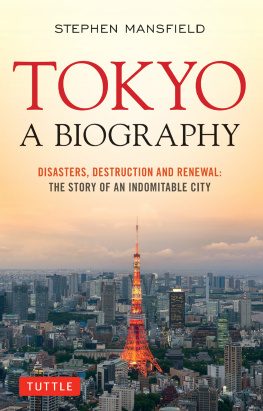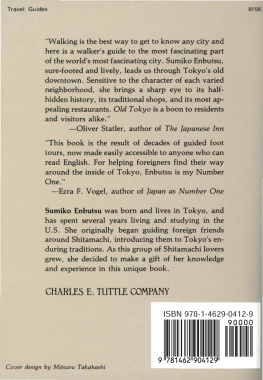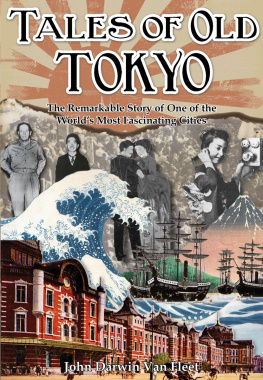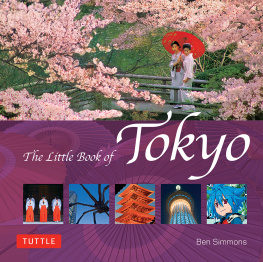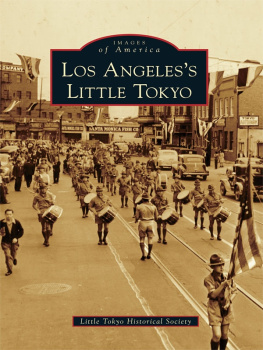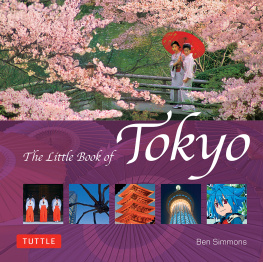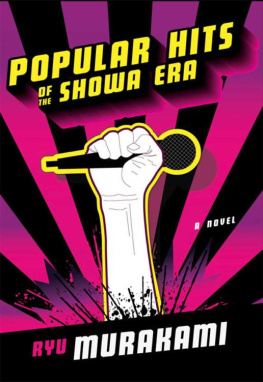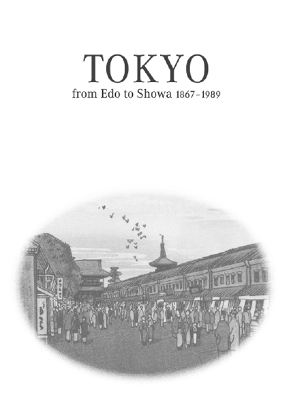

Published by Tuttle Publishing, an imprint of Periplus Editions (HK) Ltd.
www.tuttlepublishing.com
Copyright 2010 The Estate of Edward G. Seidensticker
All rights reserved. No part of this publication may be reproduced or utilized in any form or by any means, electronic or mechanical, including photocopying, recording, or by any information storage and retrieval system, without prior written permission from the publisher.
Grateful acknowledgment is made to the following institutions for permission to publish illustrations supplied by them appearing on the following pages: Tokyo Prefectural Archives: pp. 296, 299, 307, 310, 313, 331, 335, 337, 338, 339, 350, 361, 370, 372, 380, 383, 391, 396, 406, 491, 534, and 552; Asahi Shimbum: pp. 318, 346, 355, 388, 402, 416, 431, 455, 467, 471, 474, 481, 505, 516, 548, 549, and 586; Asahi Hyakka Nihon no Rekishi: pp. 425, 428, 446, and 477; Asahi Graph: p. 432; Tokyo Prefectural Government: p. 605.
English translation by Edward Seidensticker of excerpts from Collected Works of Nagai Kaf. Originally published by Iwanami Shoten, Tokyo, Japan. English translation by Edward Seidensticker of excerpts from Collected Works of Takeda Rintar, and excerpts from Collected Works of Kawabata Yasunari. Originally published by Shinchosha, Tokyo, Japan.
Grateful acknowledgment is made to the following for permission to reprint previously published material: Chuokoron-Sha, Inc.: English translation by Edward Seidensticker of excerpts from Collected Works of Tanizaki Junichir. Copyright 1934 by Tanizaki Junichir. Reprinted by permission of Chuokoron-Sha, Inc., 2-8-7, Kyobashi Chuo-ku, Tokyo 104, Japan. Keiso Shobo, Ltd.: English translation by Edward Seidensticker of excerpts from Collected Works of Takami Jun, Vol. XIX, 1974. Reprinted by permission of Keiso Shobo, Ltd., Tokyo, Japan.
Library of Congress Cataloging-in-Publication Data
Seidensticker, Edward, 1921-2007.
Tokyo from Edo to Showa, 1867-1989 : the emergence of the worlds greatest city : two volumes in one, Low City, High City and Tokyo rising / Edward Seidensticker ; introduction by Paul Waley ; preface by Donald Richie.
p. cm.
Includes bibliographical references and index.
ISBN 978-1-4629-0105-0
1. Tokyo (Japan)--History--1868-1912. 2. Tokyo (Japan)--History--20th century. 3. Tokyo (Japan)--Social life and customs. 4. Tokyo (Japan)--Social conditions. 5. City and town life--Japan--Tokyo--History. 6. Social change--Japan--Tokyo--History. 7. Japan--History--Meiji period, 1868-1912. 8. Japan--History--Taisho period, 1912-1926. 9. Japan--History--Showa period, 1926-1989. 10. Capitals (Cities)--Case studies. I. Title.
DS896.64.S425 2010
952.13503--dc22
2010011099
ISBN 978-1-4629-0105-0
Distributed by
North America, Latin America & Europe
Tuttle Publishing
364 Innovation Drive
North Clarendon, VT 05759-9436 U.S.A
Tel: 1 (802) 773-8930; Fax: 1 (802) 773-6993
info@tuttlepublishing.com
www.tuttlepublishing.com
Asia Pacific
Berkeley Books Pte. Ltd.
61 Tai Seng Avenue #02-12
Singapore 534167
Tel: (65) 6280-1330; Fax: (65) 6280-6290
inquiries@periplus.com.sg
www.periplus.com
Japan
Tuttle Publishing
Yaekari Building, 3rd Floor
5-4-12 Osaki, Shinagawa-ku
Tokyo 141 0032
Tel: (81) 3 5437-0171; Fax: (81) 3 5437-0755
tuttle-sales@gol.com
14 13 12 11 10 10 9 8 7 6 5 4 3 2 1
Printed in Singapore
TUTTLE PUBLISHING is a registered trademark of Tuttle Publishing, a division of Periplus Editions (HK) Ltd.
CONTENTS
|
|
LOW CITY, HIGH CITY |
|
| |
| |
| |
| |
| |
| |
TOKYO RISING |
|
| |
| |
| |
| |
| |
| |
|
|
INTRODUCTION
T here can be few cities in the world that live, pulsate, and breathe through their geography as Tokyo does, few cities with a history that shifts through the creases of space as does that of Tokyo. This is particularly ironic in a city whose neighborhoods today hold few distinctive features and whose gentle topography has been all but obscured by batteries of buildings. But it was not always so, and what better way is there of writing Tokyos history than by reflecting this shifting geography as neighborhoods prospered and declined while others, more aspirational, climbed up the socio-spatial ladder? This is precisely what Edward Seidensticker does in the pages of these two books, brought here together for the first time under one cover thanks to the efforts of a number of people, including Donald Richie, and the publisher.
Few books in whatever language are so suffused with the spirit of a city as Seidenstickers classic accounts, suffused with the spirit of the city, but also imbued with the wit of their author. These are not conventional histories. While they are written with a strong sense of historys ebb and flow, they are held together by their representation of the decline and marginalization of a way of life that was at the same time a part of town. Throughout these books, there is a sense of foreboding and of a fatal destiny being played out. But at the same time, there is a lightness of touch and an appropriateness of the chosen detail that provokes a smile, a chuckle, and a raised eyebrow on each reading.
This is definitely not anyones Tokyo. It is Seidenstickers Tokyo. And Seidenstickers Tokyo starts in the Low City and moves out with it to embrace Asakusa. Much of these two volumes is dominated by the demise of the Low City and all that it stood for, until, that is, more recent years, when the deed is all but done and Asakusa consigned to the role of outpost for tourists. Many of Tokyos districts have a part to play in these pages, indeed they are the principal characters, invested with a personality that can change with time but that is rooted in a sense of the almost atavistic attraction of the Low City and the parvenu presumption exhibited by the districts of the High City. So it is that we see the emergence of Ginza from obscurity in the shoguns city of Edo to shop window for all that was stylish and new. Nihonbashi, the old center of the merchants city, was much more sedate, losing out slowly to the nearby district of Marunouchi. Roppongi gets short shrift as an upstart pleasure district that grew up as a result of US military facilities in the post-war period. Shinjuku and Shibuya are the back of beyond, to put it politely.
Alongside the districts, there are a number of buildings whose presence animates these books: the Twelve-Storys tower in Asakusa, destroyed in the great earthquake of 1923; Tokyo Central Station, inconveniently located in the center of the city; Frank Lloyd Wrights Imperial Hotel, which famously withstood the tremors; the citys main theatres, prominent among them the Kabukiza and the Shibuya Embuj. And people, too, whose lives have helped to shape the city and define its culturepeople like Hattori Kintar, the founder of Seik, the watch-making company; or Josiah Conder, the British architect whose influence was seminal in the teaching of architecture in Japan; or Enoken, the most famous and best-loved of Asakusas comedians; or the man called Suzuki who built a block in Shinjuku which he optimistically called Kabukich. But the individuals whose presence most influences the tenor of these books are the many writers who have built at least part of their opus on Tokyos ground, not only the likes of Tanizaki Junichir and Kawabata Yasunari, with whom many of us will already be familiar, but lesser-known authors such as Osanai Kaoru and Takami Jun.
Next page

